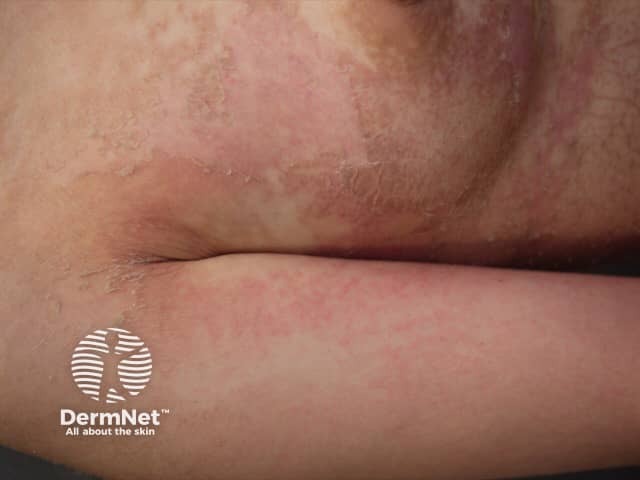Main menu
Common skin conditions

NEWS
Join DermNet PRO
Read more
Quick links
Granular parakeratosis — extra information
Granular parakeratosis
Author: Dr Amanda Oakley, Dermatologist, Hamilton, New Zealand, 2008. Updated December 2016 and June 2023.
Introduction Demographics Clinical features Diagnosis Causes Treatment
What is granular parakeratosis?
Granular parakeratosis is an uncommon red and scaly skin condition that mainly affects body folds, most often the armpits. It has a characteristic appearance under the microscope.
It is also called hyperkeratotic flexural erythema and may be the same condition as recurrent flexural pellagroid dermatitis [1].
Who gets granular parakeratosis?
Granular parakeratosis is often reported in middle-aged women but has been reported to affect babies, children and men of all races.
What are the clinical features of granular parakeratosis?
Granular parakeratosis can present as an intertrigo (rash in body folds) or as a non-intertriginous rash. It presents as a red or brown patchy scaly rash, most often in the armpits or in other skin folds. It is sometimes itchy. In severe cases, the rash spreads widely over the trunk. As it heals, the skin peels off (desquamation), resembling the peeling seen in pellagra.

Granular parakeratosis

Granular parakeratosis

Granular parakeratosis
See more images of granular parakeratosis.
How is granular parakeratosis diagnosed?
Granular parakeratosis is diagnosed by skin biopsy. There is a distinctive reaction pattern on histopathology (parakeratosis, hypergranulosis (hence its name), acanthosis, papillomatosis and prominent blood vessels).
The affected areas should be swabbed and any pathogen treated with antibiotics.
Patch testing may be helpful in identifying a contact allergen.
What is the cause of granular parakeratosis?
Granular parakeratosis is thought to be provoked by friction, occlusion, and sweating.
A defect in filaggrin production may predispose to granular parakeratosis. This protein is normally present in the upper epidermis, but there are various genetic variants that lead to a weakness of the skin's barrier function. These include a common cause of dry skin, ichthyosis vulgaris.
Cosmetic or laundry products containing the antiseptic, benzalkonium chloride, may be responsible for some cases. Acting as a surfactant, benzalkonium chloride may disrupt cellular lipid membranes and inactivate enzymes within the skin, inducing proliferation, abnormal development of the skin cells (keratinocytes), and irritant contact dermatitis. Recurrent flexural pellagroid dermatitis [1] was reported to be an irritant contact dermatitis to the anionic surfactant, sodium lauryl sulphate (SLS), in soapless cleansing bars.
This may induce proliferation and abnormal development of the skin cells (keratinocytes).
Changes in the skin microbiota have also been blamed.
How is granular parakeratosis treated?
Granular parakeratosis may resolve by itself. If due to a specific contact factor, it will settle down within a few weeks of recognising and avoiding it.
Treatments that have been reported to be useful include:
- Topical steroids — but not always
- Antiseptics
- Antibiotics eg, doxycycline
- Topical retinoids
- Keratolytic agents such as lactic acid
- Calcipotriol cream
- Cryotherapy
- Oral isotretinoin
- Botulinum toxin.
References
- Segal R, Eskin-Schwartz M, Trattner A, Feinmesser M, Hodak E, Ingber A, David M. Recurrent flexural pellagroid dermatitis: an unusual variant of irritant contact dermatitis. Acta Derm Venereol. 2015 Jan;95(1):116–7. doi: 10.2340/00015555-1862. PubMed PMID: 24696128.
- Dear K, Gan D, Stavrakoglou A, Ronaldson C, Nixon RL. Hyperkeratotic flexural erythema (more commonly known as granular parakeratosis) with use of laundry sanitizers containing benzalkonium chloride. Clin Exp Dermatol. 2022;47(12):2196-2200. doi:10.1111/ced.15358 Journal
- English JC 3rd, Derdeyn AS, Wilson WM, Patterson JW. Axillary granular parakeratosis. J Cutan Med Surg. 2003 Jul-Aug;7(4):330–2. PubMed.
- Wallace CA, Pichardo RO, Yosipovitch G, Hancox J, Sangueza OP. Granular parakeratosis: a case report and literature review. J Cutan Pathol. 2003 May;30(5):332–5. PubMed.
- Robinson AJ, Foster RS, Halbert AR, King E, Orchard D. Granular parakeratosis induced by benzalkonium chloride exposure from laundry rinse aids. Australas J Dermatol. 2016 Sep 19. doi: 10.1111/ajd.12551. [Epub ahead of print] PubMed PMID: 27641714. Pubmed.
- Ding CY, Liu H, Khachemoune A. Granular Parakeratosis: A Comprehensive Review and a Critical Reappraisal. Am J Clin Dermatol. 2015 Dec;16(6):495–500. doi: 10.1007/s40257-015-0148-2. Review. PubMed PMID: 26242230. PubMed.
On DermNet
- Scaly skin conditions
- Intertrigo (rashes in skin folds)
- Pigmentation disorders
- Benzalkonium chloride
Other websites
- Granular Parakeratosis — Medscape Reference
